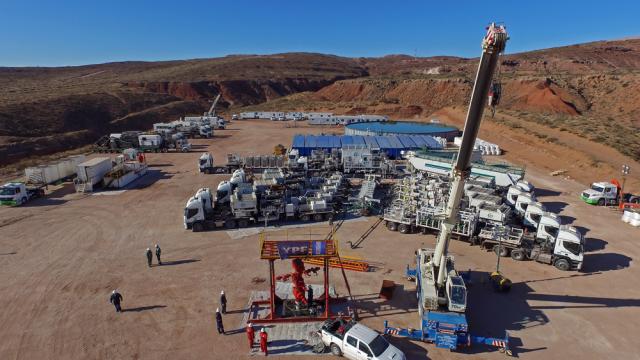
Unconventional drilling operations targeting Argentina’s Vaca Muerta formation. (Source: Shutterstock.com)
About $51 billion in investments will be required over 15 years if Argentina is to join the global LNG exporting club, according to state-owned YPF SA.
Plans revealed by YPF and its Malaysian counterpart Petronas call for a 25 million tonnes per annum (mtpa) liquefaction facility with Atlantic Ocean access. Natural gas would be sourced from Argentina’s prolific Vaca Muerta shale formation. YPF will hold a controlling 51% interest in the project and Petronas will hold the remaining 49%.
Commercialization of the shale resources could convert Argentina into the second largest LNG exporter in the Latin America and Caribbean region, only behind Mexico, bringing to market around 32 mtpa if it executes its actual, approved and planned liquefaction plants.
RELATED: Chart Talk: Mexico and Argentina’s Big Bet on LNG Exports
The lion’s share of the investments, some $31 billion, will build out liquefaction capacity and construct pipelines to transport the Vaca Muerta gas located in the Neuquén Province to a port at Bahía Blanca in the Buenos Aires province, YPF revealed in a June corporate presentation.
The first stage of the project will require $5 billion to construct a 5 mtpa floating liquefaction facility, while $2 billion will go to pipeline developments. YPF aims to make a final investment decision (FID) on the first stage by the end of 2024, it confirmed in the presentation.
The second stage of the project will require $10 billion for construction of a 10 mtpa onshore liquefaction facility and $2 billion for pipeline developments.
The third and final stage of the project will require $10 billion for construction of another 10 mtpa onshore liquefaction facility, with $2 billion for pipeline development.
Argentina’s plans to move forward with the large-scale LNG exporting project will have varying impacts across the economy and primarily boost foreign investment, allow for the industrialization and development of infrastructure and improve the country’s trade balance through increased exports.
Investments in Vaca Muerta gas blocks
Argentina’s plan to achieve LNG exports is directly linked to its ability to boost Vaca Muerta gas production in the Neuquén Province to fill the shipping infrastructure that will eventually feed the liquefaction facility.
On par with needed investments in shipping infrastructure and the liquefaction facility, boosting Neuquén’s gas production is a crucial component of Argentina’s goal to enter the LNG market.
RELATED: Argentina Goes for LNG Exporting Glory
Over 15 years, $20 billion will be needed to develop Vaca Muerta gas blocks, according to YPF.
YPF and Petronas expect to complete more than 500 wells in the first stage of the liquefaction project and tap 7 Tcf of gas reserves. In the second and third stages of the project, the companies will complete more than 2,000 wells and tap into another 28 Tcf of reserves. Those gas resources represent less than 11% of the total Vaca Muerta resources, according to YPF.
Under the plan, Argentina’s Neuquén gas production is forecast to rise by 110 MMcm/d or 3.88 Bcf/d across the three development stages of the liquefaction project.
Production from the province is expected to rise by 22 MMcm/d (0.78 Bcf/d) during the first stage, 44 MMcm/d (1.55 Bcf/d) in the second and another 44 MMcm/d (1.55 Bcf/d) in the third, according to the Buenos Aires-based energy giant.
Production from the province averaged 82 MMcm/d (2.90 Bcf/d) in the first four months of 2023, according to details posted by the government of the Neuquén Province on its website. This compares to 84 MMcm/d (2.97 Bcf/d) in 2022 and 72 MMcm/d (2.55 Bcf/d) in 2021. Average production between January 2023 and April 2023 is up 65% compared to the 50 MMcm/d (1.75 Bcf/d) produced in 2013.
Recommended Reading
Darbonne: ‘The Dance’ of US Policy Leaving Energy Mid Slip
2024-08-30 - The 1909 Matisse painting known as “The Dance” demonstrates the outcome of one of the U.S.’ pillars falling down.
Analyst: US NGL Market Tightens Links to Crude, NatGas Production
2024-08-30 - A boost in propane and ethane development is tied to the opening of the Matterhorn Pipeline in the Permian, evidence of the increasingly closer link between different sectors of the energy industry.
EDF Renewables Secures Investment in Solar Energy Storage Project
2024-08-30 - Power Sustainable Energy Infrastructure acquired a 50% stake in EDF Renewables North America’s Desert Quartzite Solar+Storage Project in California.
Energy Transition in Motion (Week of Aug. 30, 2024)
2024-08-30 - Here is a look at some of this week’s renewable energy news, including a more than $2 billion hydrogen and atmospheric gases facility in the works.
Australian Shale Wildcatter Tamboran Spuds First 2-Well Beetaloo Pad
2024-08-30 - Tamboran investor Helmerich & Payne is drilling the 2-mile laterals, while fellow investor Liberty Energy has a frac fleet en route to complete the wells, Tamboran Resources reported.






